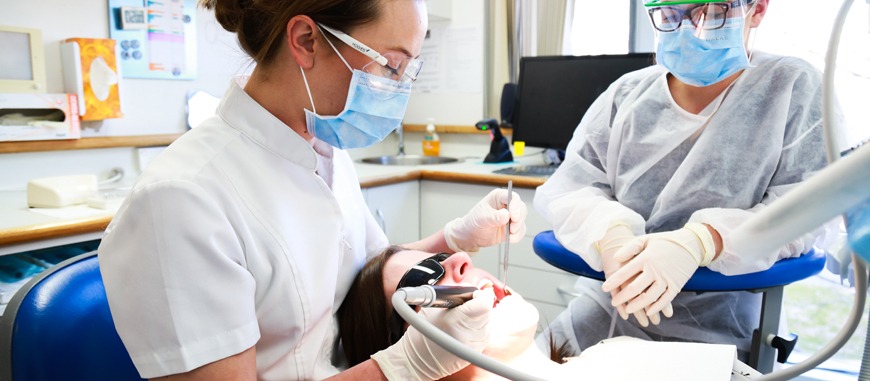Root Canal Therapy
The tooth pulp is considered as the lifeline of your tooth. It houses the nerves which are important for the sensory function of your teeth, allowing you to enjoy hot and cold food.
It is also where blood vessels are located and these supply nourishment to the tooth. Without the tooth pulp, a tooth is considered non-functional or dead.
Therefore, immediate attention and treatment should be given to a tooth with a damaged or infected tooth pulp. Teeth that have any damage to the tooth pulp are considerably weaker and more prone to breakage.
This may also cause extreme pain to the patient. For the treatment of this, Identity Dentistry dental experts recommend Root Canal Therapy.
If you have been experiencing severe dental pain, a detailed clinical and radiographic examination of the tooth may indicate that a root canal therapy (commonly known as ‘RCT’) may be required to save your tooth.
Root Canal Therapy involves the removal of damaged or infected tooth pulp and reshaping the root canal that houses the pulp.
In cases of a large tooth decay that has already reached the dental pulp, Root Canal Therapy is necessary before proceeding with any restorative treatment such as dental crowns. Bacteria build-up is highly likely in the presence of extensive tooth decay and Root Canal Therapy will help clean the root canals to prevent further damage.
Meanwhile, for dental infections such as dental abscesses, the root canal is to receive a series of medications that would facilitate the gradual healing of any dental infection and alleviate the pain for the patient.
Root Canal Therapy should be done as soon as the situation calls for it. Rest assured, Identity Dentistry dentists will exhaust all means to save your tooth and keep as much natural tooth structure as possible. This might be trying not to resist to tooth extraction and the potential extra expenses needed to replace the tooth through dental prostheses or implants.
For any dental concern that has affected the tooth pulp, our experienced dental professionals would immediately recommend Root Canal Therapy. This is so that the likelihood of dental extraction is reduced and your natural tooth is preserved.
This is also recommended as a preventive measure for any situation where they may be potential damage to the dental pulp.
Generally, dentists at Identity Dentistry recommend Root Canal Therapy for:
- Extensive tooth decay that has reached the tooth pulp
- Dental infections such as dental abscesses
- Trauma to the tooth that has inflicted damage to the tooth pulp
- Fractured teeth that reached close or up to the tooth pulp
- Existing restorations that present a large leak or recurrent decay in close proximity to the tooth pulp
If you feel a toothache, tenderness to the surrounding gums, or perhaps see dullness to the colour of the suspected tooth, it is wise to visit the dentist as soon as possible so the proper treatment is carried out before the problem gets worse.
The following are common signs of irreversible changes in the nerve of a tooth which may require a root canal therapy:
- Pain when biting or chewing
- Severe, sometimes lingering, pain from hot or cold foods and beverages, even after ceasing chewing or drinking
- A swelling or gum boil near the sore tooth
- Tender gums near the sore tooth
- Pus around the sore tooth or a bad taste in the mouth
- Darkening of the tooth
1. Consultation and Examination
Assessment of your signs and symptoms is important so our dentists know where to start. Examinations are also carried out such as taking x-rays and other diagnostic tests to determine the severity of the case. This allows us to personalise a treatment plan that is best suited for your case.
A diagnosis is made upon examination. Antibiotics and painkillers are prescribed to patients who have dental abscesses and this will help with alleviating any discomfort and ensuring a safe and relatively painless procedure for you.
2. Removing the pulp and cleaning the canal
As said, the pulp houses the nerve which houses the sensory receptors for pain. To facilitate with a painless procedure and to make the experience more comfortable for you, an anaesthetic solution is first injected. Isolation of the tooth is also necessary to prevent the spread of bacteria.
Once the decayed tooth structure is removed, your dentist will then locate the orifices of the root canal. A small access hole is made onto these holes to help remove the infected pulp with ease. The canal is also properly disinfected to ensure the removal of bacteria.
3. Filling the Tooth
If a dental infection is present, the dentist is to fill the canal with temporary medications and this is applied in a series of appointments until the infection has cleared. When clear of any dental infection and if the canal has been thoroughly disinfected and properly shaped, it is only then that a permanent filling is applied and sealed.
The permanent filling greatly enhances the strength of an otherwise already dead tooth and this allows you to carry on with the normal functions of chewing and biting without having to worry about your tooth fracturing.
Also, after the root canal treatment and depending on your discussions with your dentist and according to your treatment plan, a suitable material is placed as the tooth crown. This provides extra durability and ensures the longevity of your natural tooth.
Generally, to complete a root canal therapy there will be two main stages of treatment:
- Stage 1 is to clean out infected nerve tissue and shape the root canals for the root filling material, and
- Stage 2 is to place the root filling material in the tooth.
If you present in severe pain, emergency treatment may be required as an initial appointment to relieve symptoms, however you will still be required to return to complete Stages 1 and 2. Depending on the nature of the infection and condition of the tooth, completing the entire RCT procedure can take anywhere from 2 to 4 appointments.
The treatment typically involves the following steps:
- Initially to form an accurate diagnosis your dentist will take initial x-rays of the tooth. This may show the area of infection/abscess.
- Local anaesthetic is administered to numb the tooth.
- A small rubber sheet (called rubber dam) is placed around the tooth to isolate it from the rest of the mouth and keep the area sterile.
- If there is decay present, this will all be removed and a small access hole is made through the crown in order to access the nerve or pulp chamber in the middle of the tooth.
- Small instruments are then used to clean the tooth completely and remove the infected nerve tissue from the pulp chamber, as well as the roots.
- A medication is then placed in the tooth which helps to kill the bacteria and the tooth is sealed with a temporary restoration
- A metal band may be placed around the tooth to protect it from fracture during treatment
- When the tooth is asymptomatic and there is clinical evidence of healing, then root canals can be filled with a root filling material called Gutta Percha and the tooth is sealed. This completes the RCT treatment.
- Once the RCT is completed, depending upon the condition of the tooth, a crown may be recommended to provide long term protection for the tooth.
In cases of a long-standing infection or if a chronic abscess has developed at the end of the tooth, additional appointments may be required to allow for complete healing of the infection prior to commencing Stage 2. This process involves re-dressing the tooth by placing a new medication in the tooth. This takes place in between Stages 1 and 2.
If you are looking for a professional diagnosis or a consultation for a possible Root Canal Therapy in Canberra, Identity Dentistry guarantees that you are in the safest hands with our highly experienced dental professionals.
Our dentists have extensive experience performing this treatment and understand how important it is to guide you through the process so you understand what is happening every step of the way. Please contact us in order to book a consultation to discuss your treatment options.



